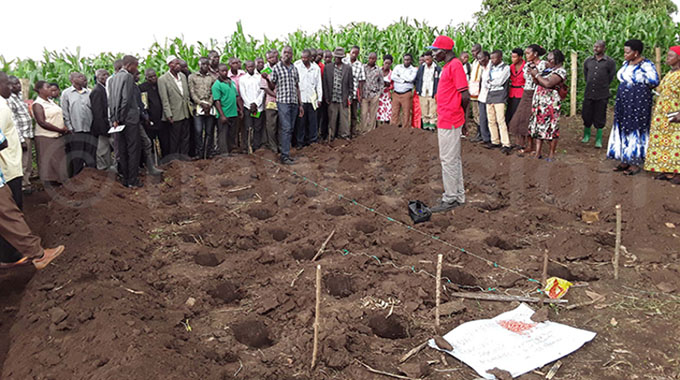
Obert Chifamba Agri-Insight
LAND preparations for the 2020/21 farming season have started in earnest with most farmers on dry land pushing to plant with the first meaningful rains.
Those producing under Government programmes such as ‘Pfumvudza’ have since upped the tempo, with most fields, especially in communal areas, now filling up with holes.
It is important to appreciate that the forthcoming season’s preparations are happening under two very different scenarios.
There is the group that is benefitting from Government sponsored pragrammes, which will naturally be the biggest winners given that the current economic environment is not very friendly to farmers producing on small hectarages and sponsoring operations on their own.
The cost of land preparations such as tillage are currently swinging between US$65 and US$75 per hectare while ripping is going for about US$60 per hectare, and these are dry rates we are talking about, which are not inclusive of the cost of fuel.
If the fuel cost is factored in, it means the charges will be astronomically high and essentially unaffordable for the resource constrained smallholder farmers.
Discing is about US$40 as well.
The farmers we are talking about here are getting the bulk of their earnings in local currency and what makes their situation more complicated is that service providers are quoting charges for their various services in US dollars and instead of sticking to the auction rate that is hovering around $82: US$1 at the moment, they are asking for between $110 and $120, which is way out of reach of the majority. In this case the black market has become the farmers’ biggest nemesis, as they try to plan ahead of the novel season.
There is also Covid-19 on the other hand that is not making it any easier, with preparations turning out to be more expensive than any other season, as the farmers have to invest in protective clothing, sanitisers, education of labour, establish a quarantine facility and observe all the measures outlined for the containment of the virus.
This limits the number of people working on the farm as farmers will be trying to observe social distancing while they still need to be always aware that if one of the workers tests positive for the virus, there is need for a contingency plan.
The plan may include suspending operations for some time, which will eat into the precious time that was supposed to be committed to preparations.
Inputs are readily available this time around and were distributed in time throughout the country but the cost of accessing them is unaffordable to the extent that when converted to the local currency they do not make economic sense to the farmers.
There is also the problem of some workers demanding payments in hard currency yet their employers who happen to be the farmer are getting paid using local currency.
Efficiency on the farm will be grossly compromised with most farmers struggling to raise enough cash to buy food for the workers or even mobilise stock for their grocery shops in the event that they have such facilities on site for the benefit of farmers.
There is a high risk of many farmers failing to secure protective clothing for their farmers in the face of Covid-19 but this will not mean that they are not willing to protect them. Last season prices were constant as most people were still using the US dollar and land preparations were affordable with farmers getting good hiring deals.
The finance component was stable and commodities like fuel were sold in hard currency and were readily available with farmers also able to service implements.
Farmers could get spare parts for equipment at affordable prices while the selling of crops like maize was not restricted to the Grain Marketing Board (GMB). Farmers were able to negotiate prices at various markets, making it easier and faster to get the money they wanted when they wanted to use it.
Fertilisers were a bit difficult to find at the beginning of last season, but they were eventually readily available on the market as the season wore on.
Fuel prices being quoted this time around make it very difficult for farmers to prepare effectively, as fuel sold in local currency is affordable but hardly available for the farmers to purchase and power implements yet the US dollar quoted fuel is readilyavailable, but out of reach for the majority.
Land preparations will this time around be very expensive to the point of making farming less profitable.
For farmers getting Government assistance, land preparations have been underway with those under Pfumvudza starting as early as May and June and most look set to meet targets set by the Government.
Inputs for the programme will be distributed starting first week of September while those not part of the programme will still be battling to raise the money to secure inputs such as seed, fertilizers and even fuel for the powering of implements.
For Pfumvudza, farmers mostly use the hoe, which does not require them to fork out any cash except for labour.
To date more than 1.6 million farmers in eight rural provinces have been trained on the Pfumvudza concept, with more than 200 000 already registered for inputs.
The climate proofed Presidential Input Scheme, which is a flagship of the Agriculture Recovery Plan targets to support over 1.8 million vulnerable households with a standard input package comprising seed, fertiliser, and Fall Army-worm pesticide.
So far, 4 790 agricultural extension officers across all the eight rural provinces have been trained on the concept and its tenets while in excess of 1 623 361 smallholder farmers, which is 90 percent of Government’s target, had been trained by extension officers as at 14 August 2020.
Training of farmers is expected to be completed by mid-September.
Farmers going it alone face the risk of downsizing their hectarages this coming season, which in essence will not be good for production and the national goal to achieve food self-sufficiency.
